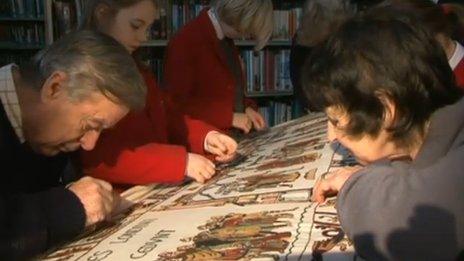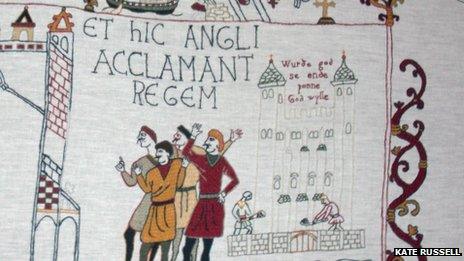Bayeux Tapestry ending made in Alderney
- Published

More than 400 of Alderney's 2,400 residents have worked on the tapestry project
Stitchers in the tiny island of Alderney have completed their version of the Bayeux Tapestry ending.
The tapestry is 70m long and woven to tell the tale of the final days of King Harold's final encounter with William the Conqueror in battle.
But until now that tale did not include the coronation of William, which happened on Christmas Day 1066.
Historians believe the final segment of the Bayeux Tapestry was lost so islanders began making their own.
Members of the Alderney Tapestry Project started the project a year ago and have just finished.
Kate Russell, Alderney librarian, along with 416 Alderney residents worked on the project.
She said: "I have been fascinated by the Bayeux Tapestry since I first learnt about it. When we thought about it we thought, 'why not make something original to the Channel Islands?'"
It is thought the original tapestry was started within a decade or so of the Battle of Hastings. It was discovered in the early 18th Century and ended with the death of King Harold at Hastings.
The Bayeux Tapestry was commissioned by William the Conqueror's half-brother Bishop Odo to celebrate his victory over Harold Godwinson at the Battle of Hastings in 1066.
It was unveiled in 1077 at the dedication of the Bayeux Cathedral and shows events from a Norman point of view from the death of King Edward the Confessor to the Norman victory over the English, with the missing section probably showing his coronation.
The Channel Islands were part of the Dukedom of Normandy when William invaded England in 1066 and won the crown.
More than 600 people, 200 horses and 50 Latin inscriptions were included in the Bayeux Tapestry
The people of Alderney, with help from visitors from around the world, have been working since early 2012 on completing the story - taking it up to the coronation of William.
Robin Whicker, from the tapestry project, said: "Nobody knows exactly how the Bayeux Tapestry would have ended but this one shows the fact that William was crowned by the unstated fact that not everyone approved."
The tapestry has been created at Alderney library with visitors to the centre adding stitches.
"One of my great delights has been watching the reaction of the artist who designed our tapestry," project head Ms Russell told BBC Radio 4's Today programme.
"She has put in the stitches herself and felt that it was coming to life in a way that she had not possibly imagined and was thrilled by it."
She added: "I can't tell you how excited we have been all along the project with the number of people who have cared, they have come from all corners of the world and all age groups."

The tapestry ends with the construction of the tower of London
The public's contribution to the tapestry is now over and Ms Russell will be tying together the loose ends.
The finished ending to the Bayeux Tapestry will be unveiled in Alderney on 1 April.
Ms Russell is currently in talks with a museum on how best to preserve the new work for future generations.
She said: "This has to be its home initially because this is where it was created but would I like to see it at the end of the original tapestry? Sure."
- Published9 February 2013
- Published9 February 2013
- Published3 February 2012